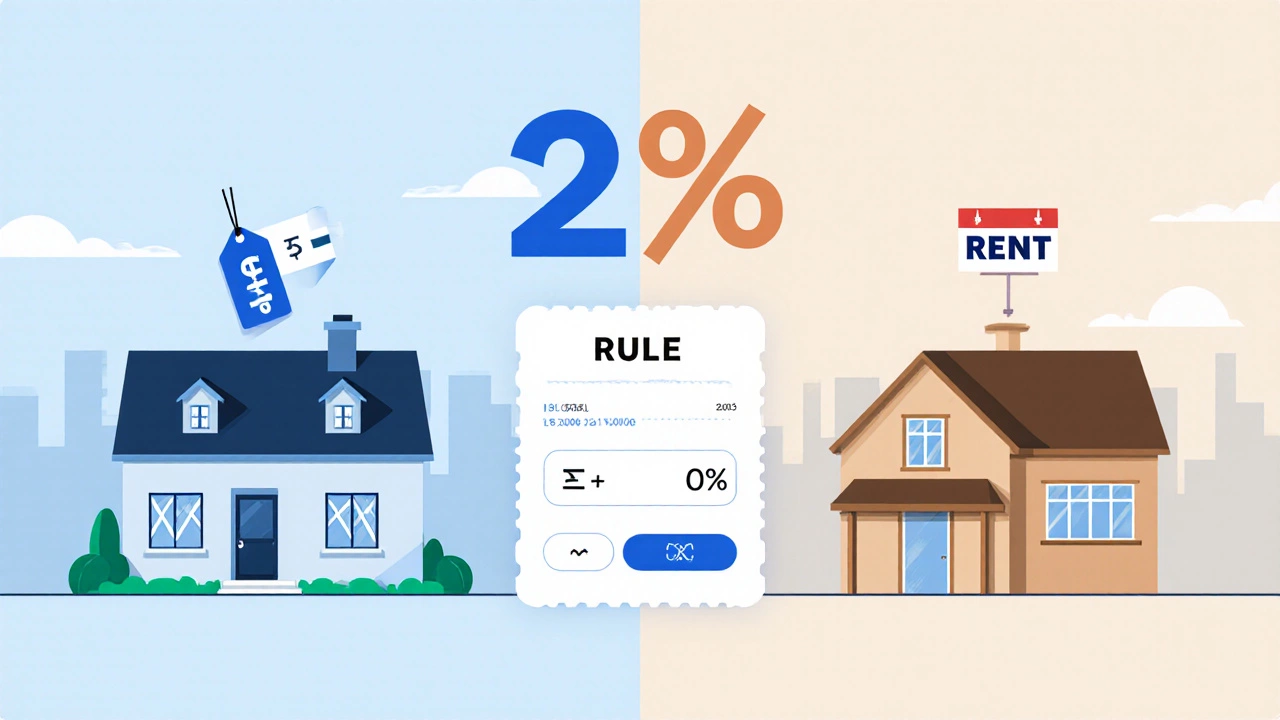2% Rule Investment Property Calculator
Property Input
Advanced Analysis
For more accurate analysis, include these additional details:
Quick Takeaways
- The 2% rule says monthly rent should be at least 2 % of the purchase price.
- It’s a fast screen, not a final decision tool.
- Factors like vacancy, management fees, and mortgage costs can flip the numbers.
- Use it alongside cap rate and cash‑on‑cash return for a fuller picture.
- Run a simple checklist before you commit.
What the 2% Rule Actually Means
When evaluating a rental, the 2% rule is a quick benchmark that suggests the monthly rent should be at least two percent of the total acquisition price. In plain English, if a property costs $250,000, you’d want to collect about $5,000 per month in gross rent.
This rule first popped up in landlord forums in the early 2000s and stuck because it lets you toss out bad deals in seconds.
How to Apply the Rule - Step‑by‑Step
- Identify the purchase price you’ll actually pay (including closing costs).
- Multiply that price by 0.02 (2 %).
- The result is the minimum gross monthly rent you should target.
- Compare the figure to real‑world market rents for comparable units.
- If the market rent falls short, dig deeper into expenses - the rule is a starting point, not the end.

When the Rule Works Best
The 2% rule shines in high‑growth, high‑rent markets where property prices haven’t yet caught up with rental demand. Cities like Austin, Nashville, or parts of Queensland often meet the rule for single‑family homes and small multifamily blocks.
It also works for investors who need a fast “yes‑or‑no” filter before committing time to a full cash‑flow model.
Common Pitfalls and Hidden Costs
Relying solely on the rule can mask several reality checks:
- Operating expenses (property taxes, insurance, repairs) can easily eat 30‑50 % of gross rent.
- A realistic vacancy rate of 5‑10 % further squeezes cash flow.
- If you’re financing, mortgage payments add a fixed burden that the rule doesn’t consider.
- Professional property management typically costs 8‑10 % of collected rent.
When those line items push your net cash flow below $0, the property fails the rule in practice, even if the gross rent passes the 2 % threshold.
Comparing the 2% Rule with Other Metrics
| Metric | What it measures | Typical range for good deals | Pros | Cons |
|---|---|---|---|---|
| 2% Rule | Gross rent vs. purchase price | >=2 % | Quick screen, easy to calculate | Ignores expenses, financing, vacancy |
| Cap Rate | Net Operating Income ÷ Purchase Price | 6‑10 % for residential, 8‑12 % for small multifamily | Accounts for operating costs | Still excludes financing; requires accurate NOI |
| Cash‑on‑Cash Return | Annual cash flow ÷ Cash invested | 8‑12 % for well‑managed rentals | Shows investor’s actual cash return | Needs full financing details; more complex |
Use the 2% rule as your first net, then move to cap rate and cash‑on‑cash for a deeper dive.

Real‑World Example - Does the 2% Rule Hold Up?
Imagine a suburban duplex listed for AUD 600,000 in Sydney’s outer ring. Closing costs add another AUD 15,000, bringing the total outlay to AUD 615,000.
- 2 % of 615,000 = AUD 12,300 gross rent needed per month.
- Local market data shows each unit rents for AUD 3,700, or AUD 7,400 total - well below the 2 % target.
At first glance, the rule says “no go.” But let’s plug in expenses:
- Operating expenses (tax, insurance, repairs): 35 % of gross = AUD 2,590.
- Vacancy reserve (5 %): AUD 370.
- Property management (9 %): AUD 666.
- Net Operating Income (NOI) = 7,400 - 2,590 - 370 - 666 = AUD 3,774.
- Assume a 30‑year loan at 5 % interest, 20 % down (AUD 123,000). Monthly mortgage ≈ AUD 2,470.
- Cash flow = NOI - mortgage = AUD 1,304 positive.
Even though the gross rent missed the 2 % rule, the property still generates cash after financing. That’s why seasoned investors treat the rule as a flag, not a verdict.
Checklist - Using the 2% Rule Effectively
- Confirm the purchase price includes all acquisition costs.
- Research comparable rental listings for realistic gross rent.
- Calculate the 2 % threshold and see if the market rent meets or exceeds it.
- Run a quick expense estimate (30‑45 % of gross) to spot red flags.
- If the rule passes, move on to a detailed cash‑flow model (cap rate, cash‑on‑cash).
- Re‑evaluate after any major market shift (interest‑rate change, new zoning).
Frequently Asked Questions
Does the 2% rule apply to commercial office spaces?
It can, but office rents are usually expressed per square metre rather than per unit, so you’ll need to translate the 2 % threshold into a per‑sq‑m rate. Many investors prefer cap rate for pure commercial deals.
What if the market rent is 1.8 % of the price?
A 1.8 % figure doesn’t automatically reject the property. Subtract expected expenses and financing costs - if cash flow stays positive, the deal may still be worthwhile.
Can the rule be used for multi‑family buildings with many units?
Yes, but scale matters. Larger portfolios often benefit from economies of scale, so a slightly lower rent‑to‑price ratio can still produce solid returns.
How does vacancy affect the 2% rule?
Vacancy reduces the effective gross rent. A 5 % vacancy cuts the rent by that percentage, so a property that barely meets 2 % may fall short once vacancy is factored in.
Should I use the rule for houses that need renovation?
Add the estimated rehab cost to the purchase price before applying the 2 % test. Renovations can boost rent, but they also raise the denominator.

